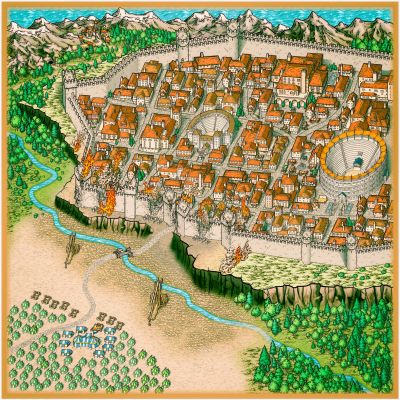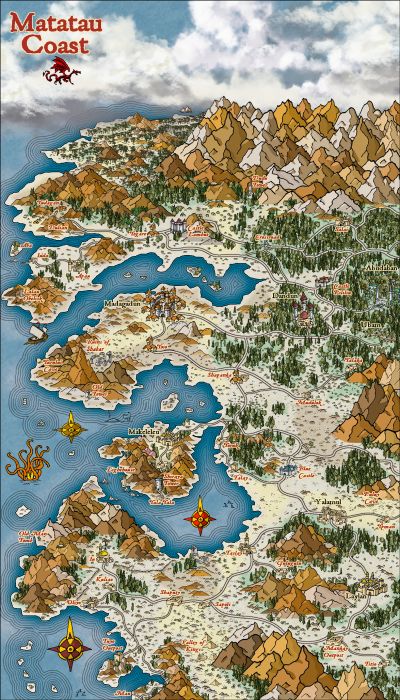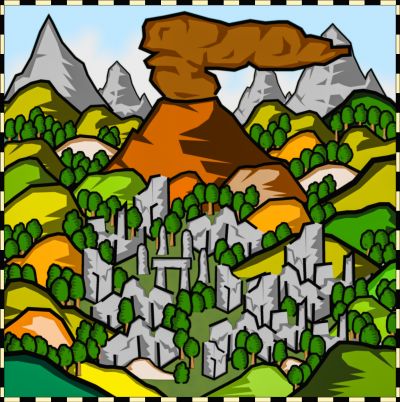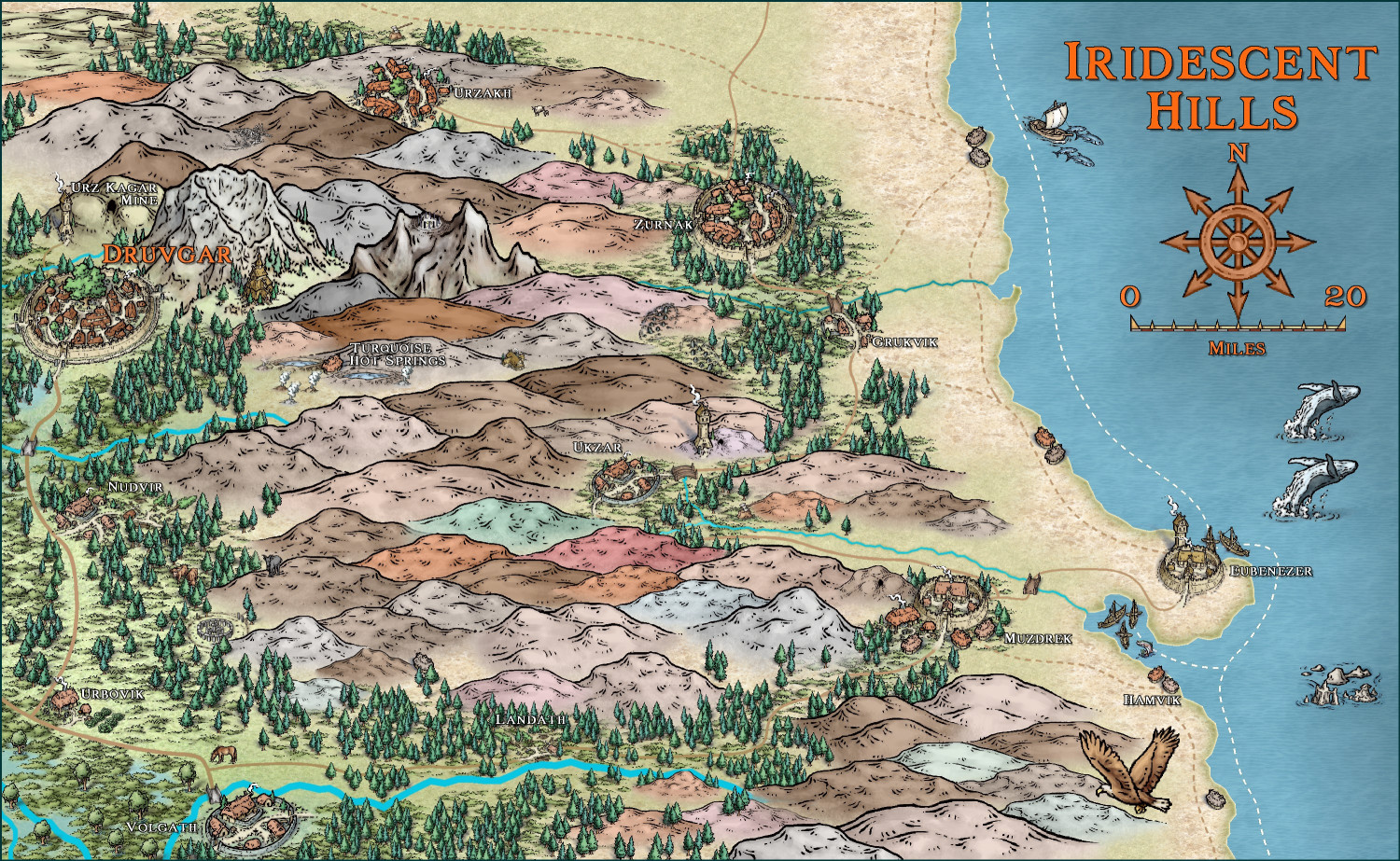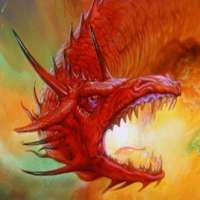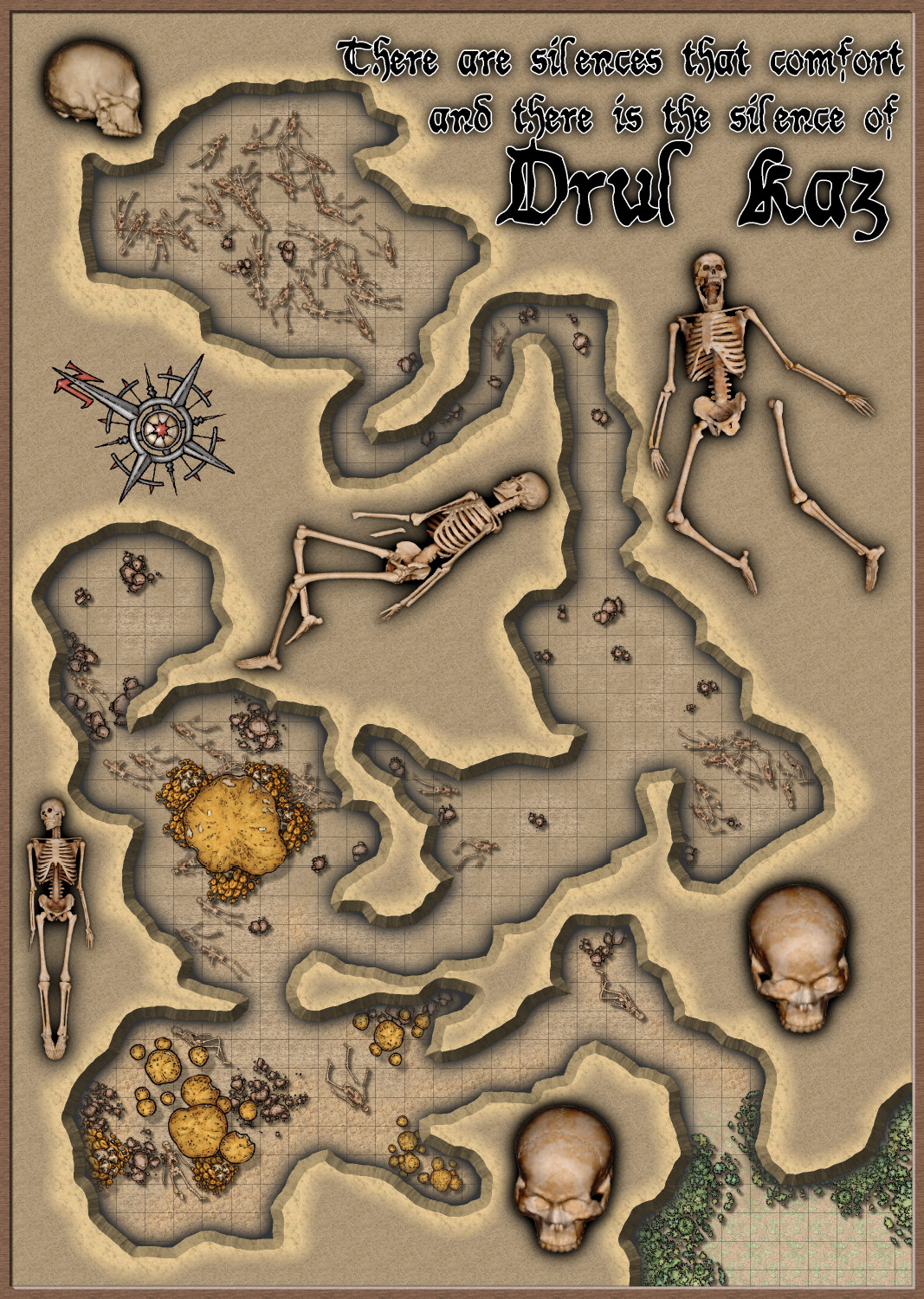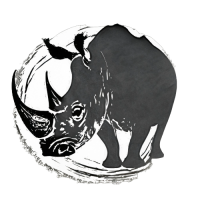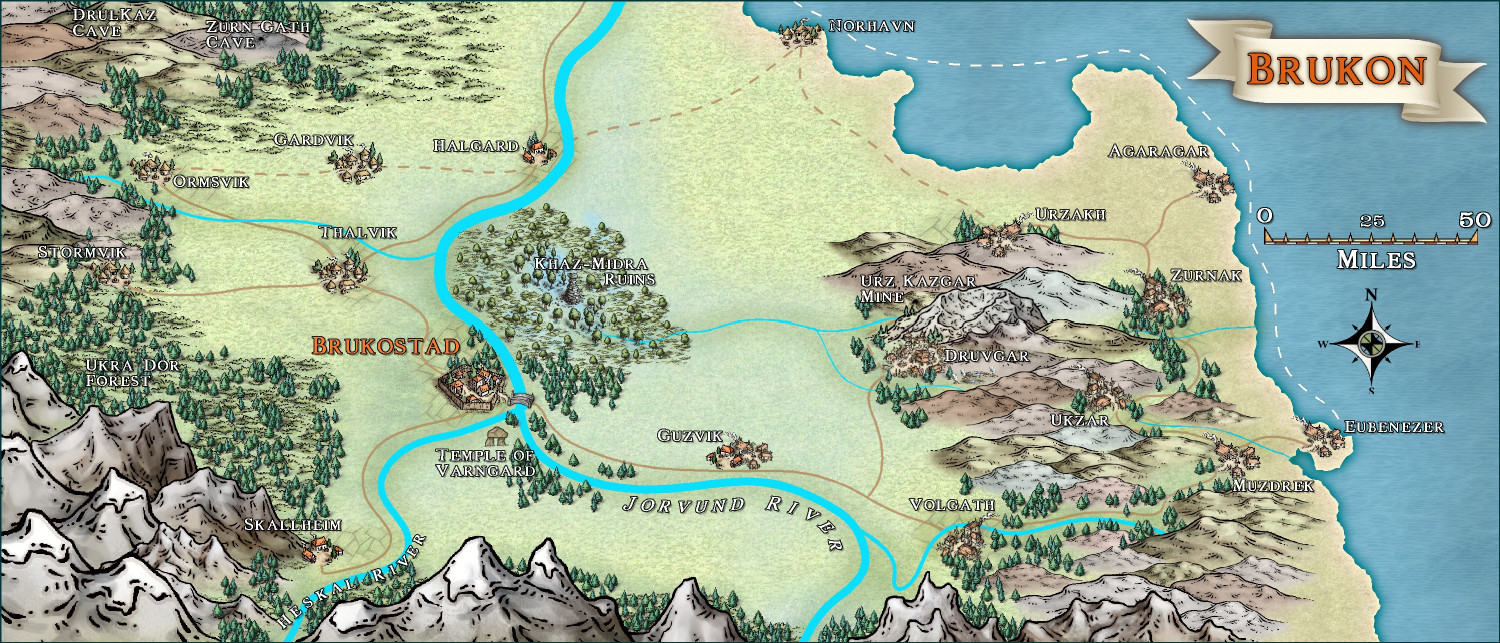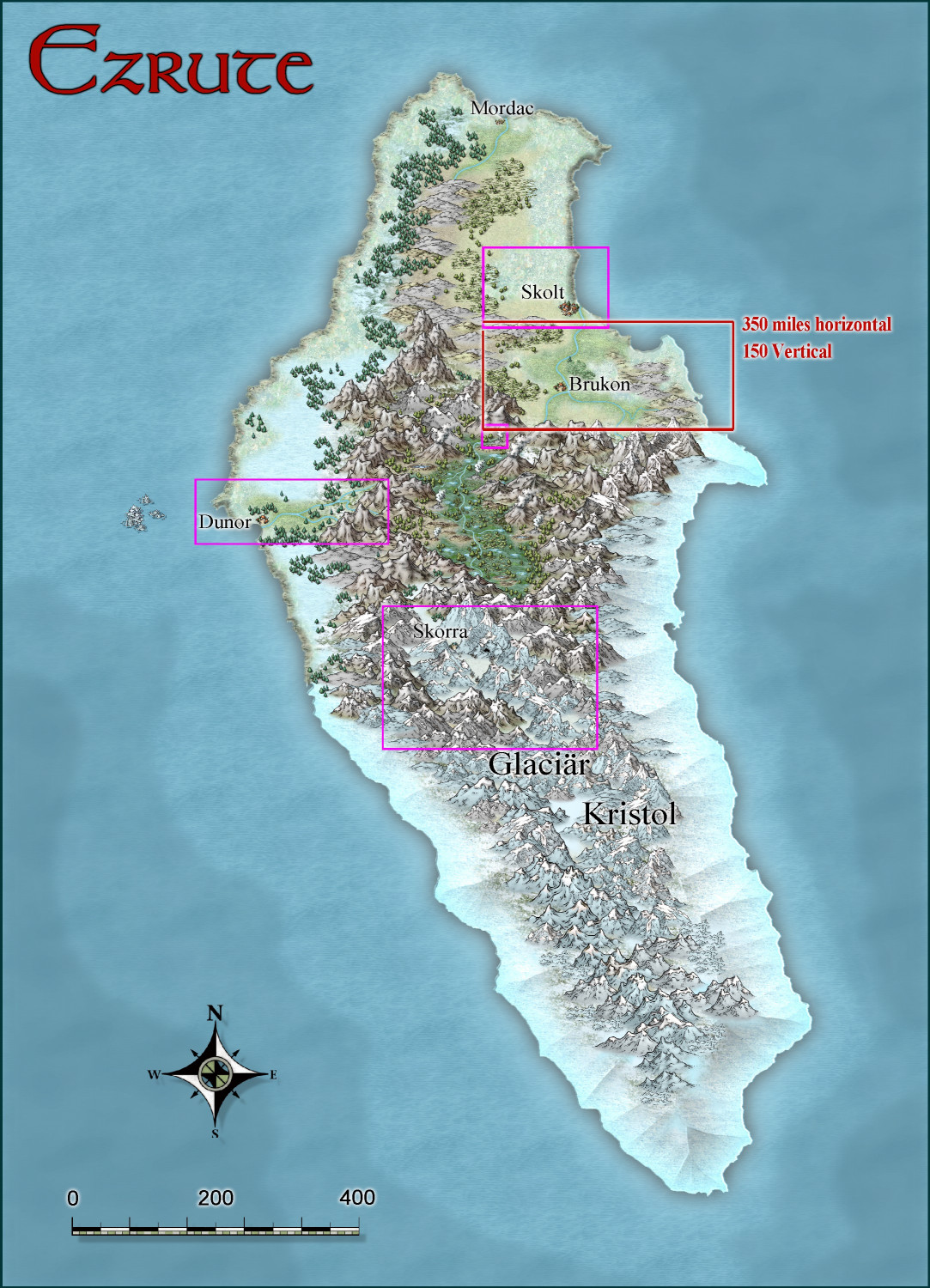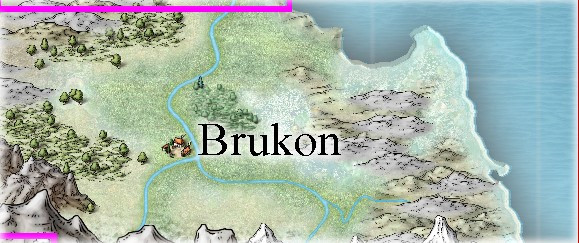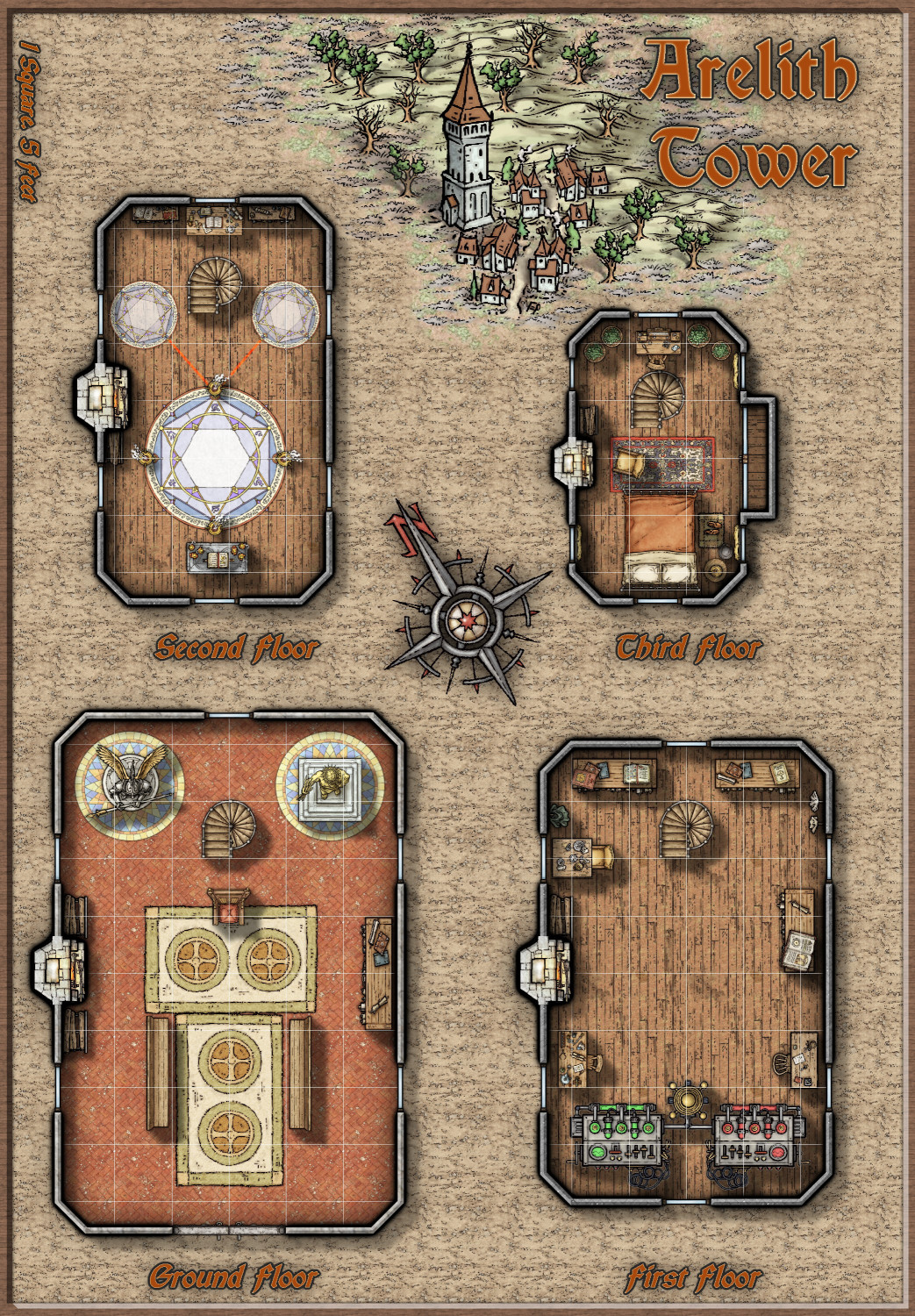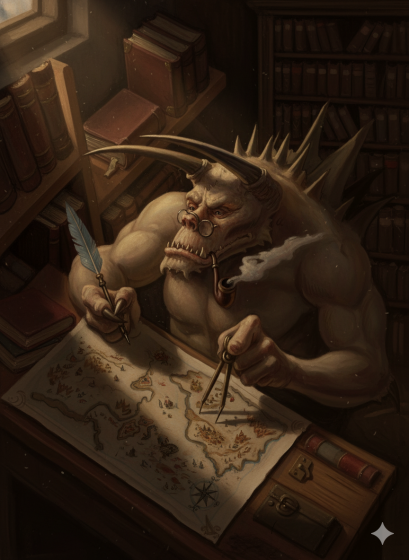
Ricko
Ricko
About
- Username
- Ricko
- Joined
- Visits
- 6,688
- Last Active
- Roles
- Member
- Points
- 10,516
- Birthday
- February 7, 1977
- Location
- merlo san luis argentina
- Rank
- Mapmaker
- Badges
- 22
Reactions
-
Community Atlas - Ezrute - Brukon Region
Orc time 💪
Iridescent Hills
East of the Jorvund River lies a humid region less suited to animal husbandry than its western counterpart, and even further east – the Iridescent Hills. In the past, these lands were seen as a forced exile for the defeated orcs after the great battles against the men of the north. The latter, in turn, took possession of the fertile plains and considered themselves the victors, lords of the best lands. However, necessity leads to adaptation – or death – and the orcs chose to adapt.
Until then semi-nomadic, they were forced to change their way of life. The new territory pushed them to permanent settlements, and there, generation after generation, they built their new communities. Proud tribes, with a strong sense of belonging and a deep knowledge of nature, worked together to shape their own survival. What had been an exile became, in time, a stronghold of strength, growth and independence. They embraced their destiny and prospered.
1. Economy and Evolution
The orcs' adaptation was not only due to their survival in the new way of life they had adopted, but also to their economic progress. They soon discovered that the land held something even more valuable than livestock or crops: minerals. Iron and copper, abundant in the hills, became the basis of a new economy. The hard work of the tribes led to the creation of mines and forges, resulting in the production of metal bars, tools, weapons and jewelry. Trade with Brukostad became highly profitable, allowing the orcs to leave behind the poverty of their early years and, over time, even establish a favorable trade balance.
The economic transformation strengthened their society. In a few generations, the orcs of the Iridescent Hills went from being seen as refugees to becoming respected merchants and blacksmiths. Their skills in metallurgy were recognized throughout the region, and their growing wealth aroused both envy and fear among the men of the North. What began as a marginalized territory now stood as a symbol of strength, with prosperous cities and a people proud of their ability to overcome obstacles.
2. Political Structure and Laws
The society maintains its community traditions and has developed a political system based on cooperation and consensus. Inspired by ancestral customs and influenced by the new economic reality, they structured a government model that balances tradition with the need for centralized organization.
Power is exercised by the Council of Tribes, composed of chiefs from each city and community elders who make fundamental decisions about trade and defense. This council elects a Supreme Chief, a position granted to a leader of great wisdom and prestige, chosen by the vote of the council's representatives at a time of greatest need.
Orcish laws reflect a society of strong collectivity, where the common good usually trumps individualism. Some of the main legal traditions include:
• Right to Land and Work: No orc can be the absolute owner of the land or mines. The use of resources is determined by the council, ensuring that the entire community benefits from extraction and trade.
• Collective Forges: The great forges are operated jointly by families and tribes, each contributing and receiving their share of the profits.
• Honor and Work: Those who refuse to contribute to society, whether in defense, extraction, smithing, or trade, are seen as unworthy. Without severe punishment, they are marginalized, and must prove their worth through service to the community.
• Tribal Code of Justice: Serious crimes, such as treason against the people or theft of community resources, are judged by the council. Punishment ranges from hard labor to exile, depending on the severity of the offense.
• Protection of the Ancestors: Ancient temples and caves are respected, and their secrets are preserved.
• The Right of Blood: If an orc is unjustly wronged, he or his family may demand formal compensation from the council. Minor disputes are resolved through ritual challenges, ensuring justice without the need for internal warfare.
3. Culture and Society
Collectivity is at the heart of this culture's identity, and every custom, tradition, and artistic expression reflects this spirit of unity. The local orc language derives from an ancient tribal tongue, rich in guttural sounds and deep intonations, but due to constant contact with human traders, many orcs also speak a rudimentary form of the northern language, used especially in trade. Internal dialects vary very little between tribes, while human words gradually begin to form part of their vocabulary.
Spirituality is deeply linked to respect for the spirits of the land and ancestors. Shamans play an essential role, interpreting omens and conducting rituals to balance the physical and spiritual worlds. Sacred caves serve as pilgrimage sites, where warriors and leaders seek visions before making important decisions. There is nothing better to strengthen community ties and connection with tradition than festivities, here are a few: During the Blood Oath Ceremony, young people who come of age gather to promise loyalty to the people before the Council of Tribes. Each person faces a physical challenge, makes a vow of service to the community and burns a hair or piece of leather to seal their connection with their ancestors. On Remembrance Day, families visit the graves of their ancestors, leaving offerings and telling stories of the great deeds of the past. At nightfall, the community gathers around bonfires to remember those who came before, reinforcing the continuity of the people.
In addition, the Iron Games are an annual celebration of the strength and skill of the orcs. Competitions in stone lifting, wood cutting, weapon forging and fighting honor the vigor and ingenuity of the people. The winners receive great prestige and earn the right to lead hunts, troops and commercial expeditions in the next cycle.
Their art is manifested primarily in jewelry, metal sculpture, and tribal adornments. Weapons and armor are carved with runes and patterns that tell stories. Their music is intense and percussive, with drums and ritual chants used in celebrations and battles.
The population that inhabits Iridescent Hills is mostly orcish, but there are a significant number of half-orcs, descendants of orc-human relations. Unlike in human settlements, where they face severe prejudice, here they are accepted, but often considered “doubly displaced.” Lacking the physical stature of full-blooded orcs and lacking full acceptance from both worlds, many half-orcs end up taking on intermediary roles, as small traders or even mercenaries. Some prosper, but all struggle hard to find their place.
4. Military and Defense
Defense is based on collective strength and adaptation to the terrain. Major cities, such as Druvgar, have reinforced palisades and watchtowers, with sentries on duty day and night. Outposts in the hills ensure that any hostile movement is detected before it reaches the settlements.
The military structure is decentralized but highly efficient. Each tribe maintains its own militia, made up of experienced warriors and young men in training. In times of war, these forces unite under the leadership of a commander chosen by the Tribal Council, usually a renowned warrior or a veteran chief. It is worth mentioning that they are experts in ambushes and guerrilla warfare, taking advantage of the terrain to compensate for any numerical disadvantage.
Ironically, however, the orcs have been reversing the balance of power in the valley over the past few years. With their mastery of metallurgy and the wealth generated by the trade in minerals and forged goods, the orcs now possess weapons and armor superior to those of the human forces in the region. Iron mined from the hills, once exchanged at disadvantageous conditions, now equips orc warriors with refined steel blades and robust armor, while human armies, once so superior, are beginning to feel the weight of their technological lag. Tribes that once fought with efficient, albeit primitive, weapons now boast balanced spears, reinforced bows and sharp blades, latent proof of growing prosperity.
The alliance with other peoples is unstable. The various tribes of the Hills maintain a trade pact with human cities, but mutual distrust prevents deeper cooperation. Some tribes are seeking new maritime agreements to cut their dependence on Brukostad merchants, contributing even more to the constant tensions between leaders and merchants on both sides. Internally, power struggles between great merchants and influential warriors also occur, creating political rivalries.
In addition, external threats require constant vigilance. Raiding bands from the north frequently attack caravans, and rumors suggest that some isolated orc tribes may be exploiting hidden mines without paying due tribute to the council. This raises the risk of internal conflict, especially if a tribe gains too much power without the consent of its elders.
5. External Influences and Diplomatic Relations
Iridescent Hills maintains a pragmatic relationship with the outside world. Trade with Brukostad and other human cities is essential to the orc economy, but it is also a constant source of headaches.
To the north, raiders and mercenaries pose a constant threat to overland travel, forcing the orcs to reinforce the security of these caravans. There are rumors that smaller tribes have recently tried to strengthen ties with these factions in order to gain political advantage.
It is worth noting once again that the orcs' growing technological advantage is beginning to change their position in the geopolitical scenario. Once marginalized, they now command respect both for their military power and their economic importance. However, this rise also generates fear among their neighbors, who see them as an emerging threat.
These people do not seek domination, but neither do they accept continued exploitation.
6. Legends
6.1 The Black Goat – Guardian or Troublemaker?
Deep in the almost endless hills, between valleys and rocks, roams the Black Goat — a gigantic creature, with horns twisted like oak roots and eyes that glow like embers. Some say he is the spirit of the mountain, others swear he is just a stubborn goat... only three times bigger.
For some, he is a guide, leading lost travelers back to the path. For others, a real troublemaker, stealing supplies and leaving behind a trail of chaos. Some say he once knocked down an orc chief in the middle of a speech and ate the map of an entire expedition.
Whether an ancient spirit or just a very clever goat, no one denies his presence. He may be an ally — or the reason your dinner mysteriously disappeared. And remember: never look him directly in the eye... they say it brings bad luck!
6.2 The Bottomless Pit
Between the hills, hidden by mist, lies the Bottomless Pit, a gateway to the world of the dead. The orcs say it was dug by forgotten hands and sealed by the gods, but never completely closed. They say anything thrown into it disappears forever, sucked into the domain of the hungry spirits.
6.3 The Mistbringer
A faceless entity that appears on the coldest nights, shrouded in an eerie mist. Legends say that those who gaze upon it for too long have their bodies and souls ripped away and pulled into the mist. Ancient as the forgotten gods, it is believed to have been a guardian of gates between worlds, now corrupted. Wherever it passes, silence reigns, and only footsteps remain at dawn. It cannot be defeated, only avoided.
7. Places of interest
7.1 The Silent Eye
Atop the highest mountain in the Iridescent Hills, shrouded by fierce winds and constant cold, stands The Silent Eye—a stone temple that stood long before the orcs set foot on these lands, its origins shrouded in mystery and fear. Seen from the sky, its circular shape resembles an eye carved into the earth, ever watchful.
The few records of the temple suggest that it was built by a long-extinct civilization whose knowledge of the heavens surpassed that of the wisest shamans. As if brought from distant lands, the stones that compose it are found nowhere else in the region. Its ruins have withstood the most violent storms.
For the orcs it is a place of fear, for they fear the spirits that, according to legend, still roam among its weathered columns. On certain nights of the year, a strange light shines over the temple—a cold, yellow glow. Some believe it is a sign from the ancient inhabitants or even an attempt to communicate with the living. Others claim it is just the winds and the reflections of the moon, trying to deceive the unwary.
The elders say that, long ago, a young orc defied the warnings and climbed to the site to prove his courage. He spent an entire night among the ruins and, upon returning, he had changed. His eyes, once bright and burning, had lost their shine. He never spoke a single word again, only sat every night facing the mountain, as if he heard voices that no one else could hear and was considered a lunatic.
Since then, few have dared to venture there. Those who go and return speak of moving shadows and the uncomfortable feeling of being watched by something invisible. Perhaps the temple still fulfills its original purpose, watching over the heavens... or perhaps it has turned its attention to those who dare to disturb its silence. 7.2 Turquoise Hot Springs – The Refuge of the Orcs
Located east of Druvgar, at the base of the Zarn’Vol volcano, the Turquoise Hot Springs are one of the most revered natural treasures of the orcs of the Iridescent Hills. Their vibrant blue hot springs emerge from the warm subsoil of the dormant volcano, creating natural pools and stone reservoirs, where the temperature decreases the farther away from the source one travels. During the harsh winters, these waters become an essential refuge, attracting travelers and weary warriors in search of rest and revitalization.
Orc legends tell of the Hot Springs as a gift from the spirits of the mountain, a blessing for those who were able to harden the harshness of exile. Shamans claim that the waters have healing properties, capable of relieving pain, strengthening the body and even purifying the soul. For this reason, the site has become a center of spiritual rituals, where orcs hold ceremonies to honor their ancestors and seek guidance during difficult times. In addition to their medicinal and spiritual importance, the hot springs are a social gathering place. In winter, entire tribes gather around the stone pools to share stories, trade goods, and strengthen alliances. The warm mist rising from the waters mixes with the sparse pine vegetation, creating a scene of rare beauty, especially at sunset, when the intense colors of the sky reflect on the crystal-clear waters and the colorful hills around it.
7.2 Turquoise Hot Springs – The Refuge of the Orcs
Located east of Druvgar, at the base of the Zarn’Vol volcano, the Turquoise Hot Springs are one of the most revered natural treasures of the orcs of the Iridescent Hills. Their vibrant blue hot springs emerge from the warm subsoil of the dormant volcano, creating natural pools and stone reservoirs, where the temperature decreases the farther away from the source one travels. During the harsh winters, these waters become an essential refuge, attracting travelers and weary warriors in search of rest and revitalization.
Orc legends tell of the Hot Springs as a gift from the spirits of the mountain, a blessing for those who were able to endure the harshness of exile. Shamans claim that the waters have healing properties, capable of relieving pain, strengthening the body and even purifying the soul. For this reason, the site has become a center of spiritual rituals, where orcs hold ceremonies to honor their ancestors and seek guidance during difficult times. In addition to their medicinal and spiritual importance, the hot springs are a social gathering place. In winter, entire tribes gather around the stone pools to share stories, trade goods, and strengthen alliances. The warm mist rising from the waters mixes with the sparse pine vegetation, creating a scene of rare beauty, especially at sunset, when the intense colors of the sky reflect on the crystal-clear waters and the colorful hills around it.
7.3 Land of Sighs – The Cursed Cemetery
West of Grukvik lies an ancient cemetery, a place that even the orcs dare not name aloud. The soil there is dry and infertile for even the hardiest of plants. It is said to belong to a forgotten civilization, whose dead never found their proper rest.
The air is heavy, permeated with the metallic smell of death. Those who venture here feel the energy slowly drained from their bodies. Distant whispers echo among the cracked tombstones, and ownerless shadows glide across the graves, watching, waiting. Those who stay too long feel an unbearable cold penetrate their skin, and their bones begin to weigh them down, as if something is pulling them down – until there is no life left.
It is said that the unfortunates who succumb to the power of the cemetery rise the following night, empty of life, condemned to wander eternally, protecting that cursed ground and dragging new unwary souls to their deaths.
No one knows what cursed that place, but one thing is certain: the dead there never sleep.
-
Community Atlas - Ezrute - Brukon Region
Drul’Kaz – The Cave of Bones
Many years ago, the winter that claimed the Drul’Kaz family was the cruelest the plains of Brukon had ever seen. It came swiftly and without warning, a storm like no other where the winds cut like a butcher’s knife and the snow piled up like never before, swallowing the paths and silencing the forests. No game roamed the fields. The rivers froze to their beds and even the hungry wolves that prowled the camps were found dead, petrified by the relentless cold.
It was in this season of death that a large orc family, 61 souls in all, found refuge in a deep cavern hidden among hills of black stone. They were on the move, fleeing the cold, trying to reach milder lands before the worst of winter reached them. But the storm surprised them. The wind howled like a hungry beast, blinding them with snow and biting ice. The elders stumbled, the children cried, and the strongest warriors barely made their way.
Their leader, Urgor, a seasoned hunter, knew they could not go on. If they tried to advance, they would die one by one, buried in the snow. Then they found the cave—a dark cleft between the rocks, just wide enough to shelter them. Here, they thought, they could survive until spring came. They lit fires, cooked the last bits of dried meat, and waited.
But spring never came for them.
Days passed, and the flames began to fade. The wood was brought in, and the cave grew cold as a tomb. The air grew heavier each night. The voices became whispers. Then, one by one, they began to disappear.
The children were the first. Alone in the darkness, their eyes open but their bodies still. Then came the elders. Urgor ordered that no one should sleep alone, but it was useless—every day, fewer orcs remained to watch over the living. Some tried to escape, but the storm outside seemed more cruel than what awaited them inside. Others begged the spirits, but their prayers went unanswered.
When winter finally gave way and the snows began to melt, a group of hunters found the entrance to Drul’Kaz. The smell of death did not greet them. Only silence. They entered the cave expecting to find scattered bones, remains of a tragedy like so many others in the cold of Brukon.
What they saw probably haunted them for the rest of their lives.
The 61 orcs were still there. Their bodies were perfectly preserved, as if they had just gone to sleep. Their eyes were open, fixed on the ceiling of the cave, their expressions frozen in a mixture of surprise and horror. No sign of struggle, no apparent illness. Just an entire family, eternally trapped between life and death.
News like this soon spread, and so the stories began. Some shamans said that Drul’Kaz was a sacred tomb, a portal between the living and the dead. Others say that those who died there were not truly dead—that they could still see, hear, and feel the passing of the years, but were unable to move. Some swore they saw the eyes of the dead blinking as they entered the cave.
Since then, Drul’Kaz has become a place of fear and reverence. No tribe approaches without need. The boldest shamans sometimes go to its entrance to seek visions, but few dare enter. For the orcs, the fate of warriors must be to return to the earth to be covered once more by snow. But those who died there never returned. They never left. And if they are still there, waiting, no one cares.
-
Community Atlas - Ezrute - Brukon Region
Although the map was completed relatively quickly, it took me a little longer to introduce the fertile and flooded Brukon plain. I wanted to fit two important elements as best as possible: to the north, the Skolt region, drawn by @Quenten , and to the south, what I assume is the fertile valley described by the first cartographer, @Shessar. This valley, surrounded by a frozen environment, stands out as a rare producer of fresh food in this inhospitable continent...
But for that I needed a minimal, somewhat mysterious reason without revealing too much information about the why or how of its existence.
Cheers
Brukon: The Valley of Conquest
1. Origins and Conflict
The region of Brukon as we know it today was born from the desire for expansion of the lords and settlers of Skolt, a city located to the north, and their desire to seek more pastures. The journey south revealed a valley of brutal beauty, full of fertile grasslands and abundant pure water.
In the heart of this new land, where the Jorvund River meets its tributary Heskal, the city of Brukostad arose, the largest and busiest in the region. In the beginning, the settlements fought against a fierce enemy: the semi-nomadic orc tribes, who for centuries roamed these lands, guided by the rains and the seasons. The war between the settlers and the orcs was bloody, and every inch of land was conquered with sweat, blood and tears. The technological superiority of the men who came from the North, combined with Skolt's support, ensured victory, forcing the orcs to migrate eastwards towards the Coloured Hills, a region of rock formations rich in minerals. But the fighting did not end with the war. The memories of the massacre, of the burned villages and of the fallen warriors are a burden passed down from generation to generation, both among the settlers and especially among the orcs.
2. Flora and Fauna
Brukon's nature is both wild and magnificent. Pine forests cover the hills to the west, while weeping willows bend along the rivers. In the mild summer, fields of brightly coloured and hardy windflowers colour the green plains with abundant pasture.
In addition to the direwolves and grizzly bears, there are the Grakuls, enormous birds that fly over the rivers, diving like spears to catch fish. There are also the mysterious White Wyverns, serpents with icy scales that are said to hiss in the wind before attacking.
Along the right bank of the Jorvund River, a vast swamp stretches, always shrouded in mist, where the Ruins of Khaz-Midra are hidden. The remains of an ancient city, its buildings are crumbling domes and arches carved with complex geometric patterns. Towers now tumbled down are entangled with vines and roots, while half-submerged columns emerge from the muddy waters. It is said that this place was built by a forgotten civilization and is guarded by creatures with luminescent eyes that prowl the flooded alleys.
3. Hardships and Adaptation
In the early years, life in Brukon was a constant test. The biting cold of winter reduced the strongest to weakness. Without sturdy buildings, many families succumbed to the harshness of the season, with their frozen bodies only being discovered in the spring.
Giant wolves attacked in the dead of night, hunting animals and sometimes breaking into huts to devour the inhabitants. Worse creatures lurked in the darkness: the Skaugs, snow creatures with glowing eyes and razor-sharp claws, carried off animals, children and lone travelers. Some nights, distant screams could be heard as a premonition of imminent death.
Throughout the early years, hunger was a constant companion. The first harvests were scarce and the solution came with time: the raising of Swamp Cattle, pigs and the cultivation of black wheat, a cereal resistant to the cold. Hunters became essential, bringing in meat from moose, hares and the dangerous grizzly bear, a ferocious predator that could wipe out an entire village if provoked.
4. Daily Life, Customs and Culture
The people of Brukon have inherited many customs from their northern ancestors. They live in large communal halls, where they celebrate their achievements, tell stories and share food. Hospitality is sacred: refusing shelter to a traveler during the winter is considered a serious offense.
Honor and strength are highly valued. Young men go through rites of passage, hunting their first prey or dueling in training arenas. Women play an active role in society, being able to fight, run businesses and even govern villages. The concept of revenge is also strong, with family disputes lasting generations.
Festivals are marked by the consumption of fermented drinks, roasting meat and dancing around bonfires. During the Dawn Festival, which celebrates the end of winter, there are competitions of strength, hunting and races on the ice. The music is melodious and joyful, composed of rustic drums and flutes.
Despite the hardships of life, the inhabitants of Brukon are resilient, forged by cold and adversity. They know that between the merciless nature, the vengeful orcs, wild beasts and political instability, only the strong will survive to tell their tale.
5. Economy in Brukon
Although marked by natural challenges, the financial situation has flourished over the generations, sustaining not only the local villages but also supplying Skolt and other northern towns with essential resources.
5.1 Livestock
The vast wetlands of Brukon are an ideal environment for raising livestock adapted to the muddy soil and seasonal flooding. The Marsh Cattle are a mainstay of the local economy. Strong and resilient, this breed of cattle can forage in semi-flooded terrain, thriving where other animals would not. Their fatty milk is the basis for the famous Marsh Cheese (or “Stink Cheese” as the locals joke), a product with an intense flavor and strong odor that is both a staple food and a delicacy exported to Skolt and beyond.
Marsh Pigs, descendants of domesticated wild boars, supplement the livestock economy. Their rustic and tasty meat is highly prized in Brukostad, and is made into sausages and cured meats that sustain the locals during the long winters. Since they feed on anything else they can find, they are easy to raise and require little maintenance, making them a valuable resource for the region’s farmers.
5.2 Agriculture
Although livestock and mining are the main economic forces in Brukon, there is one agricultural crop that has become vital to the region’s livelihood and commerce: Black Wheat. This hardy variety, with its dark color and hard grains, is one of the few that can thrive in the cold, moist soil of the plains. Grown mainly during the milder periods of the year, it is the basis for a dense, nutritious bread that is essential for surviving the long winters. In addition to local consumption, it is exported to Skolt and other northern regions, and is highly valued for its durability and resistance to mold. Some noble families of Skolt pay dearly for "Storm Rye," a strong spirit made from this wheat, the production of which is kept secret by the farmers of Brukon.
5.3 Mining in the Colored Hills
Mining is another major economic force in the Brukon region. The Colored Hills, rich in minerals, provide iron, copper, and small amounts of silver. The city of Brukostad has become a key trading hub, with caravans transporting metals to Skolt, supplying the forges and arsenals of the north. The orcs, who were displaced eastward generations ago, have become skilled miners, trading the minerals they extract for tools, cloth, and food from the humans—now sedentary and mostly with greater purchasing power and access to goods.
This trade has brought development, but it has also caused tensions. The humans of Brukostad control much of the export, while the orc tribes resent their dependence on human merchants and their commissions. In addition, in recent years, some orc chieftains have begun to invest in maritime trade, seeking to ship minerals directly to distant ports without the need for human intermediaries. Small orcish ships now roam the coast, trading iron and copper with foreign merchants, increasing their own profits and reducing Brukostad's influence over their operations.
This has led to further strife. Human traders view this move as a betrayal, while the city's lords debate ways to counter this new economic threat. Rumors have swirled that some human caravans have been sabotaged by unknown parties, while orcish ships have mysteriously disappeared at sea. The precarious balance between the two cultures is more unstable than ever, and many wonder if this commercial rivalry could soon turn into something much bloodier.
5.4 The Beginning of Lumbering
With the expansion of the population and the growing demand for building materials and fuel, logging has become a new economic activity. The regions of Ormsvik and Stormvik, located to the west, near the dense forests, have become the main centers of this activity.
The black pines, tall and resilient trees, are the main targets of the lumberjacks. Its timber is prized for building houses, boats, and fortifications, and is exported to Skolt. Brukon’s economy continues to grow, but its people know that this land is not easily surrendered. Everything extracted from it—be it milk, meat, metal, or timber—comes with a price, and only the hardiest thrive.
6. Politics and Local Tensions
Trade between Brukostad and the Colored Hills became vital. The orcs learned to mininig, fish and sail the sea, while the humans benefited from the minerals extracted from the hills, which they traded for manufactured materials, furs, and grain. But the distrust never disappeared.
Marriages between humans and orcs began out of political necessity, but soon began out of love, producing a new generation of half-orcs. These individuals were viewed with suspicion by both sides, often considered bastards without real place. In times of tension, they were the first to be accused of treason. There are whispers that a group of purists in Brukostad want to expel them or, worse, eradicate them.
Brukon is still under the control of Skolt, who has appointed a Jarl, an iron ruler, to administer the region. The current Jarl, Hagvar Ulfsson, rules with a firm hand, ensuring that taxes and tribute flow to Skolt without interruption. However, there is growing resentment among the inhabitants, who want autonomy over their lands.
The lesser nobles and merchants of the region are beginning to plot for emancipation, arguing that Brukon is self-sufficient and that Skolt merely exploits them. Small riots have already broken out in smaller towns, and there are rumors that a secret council of local leaders plans to seize control of the city when the time is right.
To make matters worse, the towns of the region themselves are bitterly rivaled. Some are loyal to Skolt, fearing reprisals, while others seek independence and plot against the Jarl. This uneasy balance could crumble at any moment.
7. The Land Never Forgets – The Orc Side
Before the storms of iron and fire, the orc people of Brukon lived as they had always lived: following the cycles of nature, hunting in the grasslands and fishing in the icy waters of Jorvund. Their villages were made of wood and leather, built and dismantled as the seasons changed. Each winter was a struggle, but they knew the land, the rivers and the mountains. Their spears and bows kept the direwolves and grizzly bears at bay, and there was no fear in their hearts.
Then came the men of Skolt.
They came from the north, in small groups at first—explorers who looked longingly at the hills and valleys. The orcs saw them, but did not attack. They were few, frail, and ignorant of the dangers of Brukon. Winter would take them. But the men returned. They brought herds, built fences, and burned fields to plant seeds. They came in ever-increasing numbers, with heavy wagons and iron weapons. They built palisades where before there had been only the wind and the sound of birds.
The orc chiefs sent emissaries. The land was vast, there was room for everyone. But the men did not listen. When the snows cleared, the first fighting began. Small, stealthy skirmishes at night. But they were not just hunters or herders. Warriors came from the North, dressed in thick furs and chain mail. They marched as one, they fought as one.
The orcs resisted. They knew the plains, the hills, and the marshes, they used the fog and the vegetation as their allies. But the men had metal. They had walls and spears too long for a warrior to approach. And above all, they never stopped coming.
The battle lasted for years. Villages were burned, families torn apart. For every orc warrior who fell, two northerners took his place. The cold did not stop them, nor did hunger break them. So the tribes set out. The chiefs ordered the migration eastward, toward the Colored Hills, where men still dared not tread.
When the blood no longer watered the land, the time of truce came and trade began. Iron for meat, seafood for grain. Warriors took human wives, and children of two heritages were born. But the past never completely fades.
Among the elders, the whispers of ancient battles still echo in the silent nights. Old orc warriors look upon Brukostad and still taste the bitter taste of defeat. Human nobles mutter that the orcs are barbarians disguised as merchants. And at the center of it all are the half-orcs—children of two opposing histories, of two bloodlines that should never have mixed.
They carry the distrust of both races. Humans see in them the savagery of the orcs. Orcs see the blood of the invaders. Many live on the fringes of villages, never fully accepted.
Marriage between humans and orcs is no longer a rarity. Some families have learned to see the benefits of such a union—trade alliances, security, and in some cases, even respect. But even now, when an orc warrior takes a human wife or an orc woman marries a farmer, there are murmurs in the halls, furtive glances in the streets. But the young men of this place are beginning to see the world differently. They have grown up hearing stories of conflict, but their hands have never held a weapon against the other people.
8. Legends and Fears
The darkness of Brukon is populated by more than just wild beasts. The elders speak of the Draegrimm, specters of orc warriors slaughtered in war, who appear in snowstorms, seeking vengeance on any human who crosses their path.
Another legend is that of the Old Man of Ice, an entity who dwells in the mountains and punishes those who disrespect the land. Hunters who waste meat or kill for sport are said to find their bodies frozen and flayed, their eyes turned to pure ice.
8.1 The Ukra’Dor Forest and the Forgotten Vale
The Ukra’Dor Forest, or “Path of the Lost” in the ancient orc tongue, is a hostile territory, shrouded in a cold and perpetual mist. Twisted trees and rugged terrain make it treacherous. Whispering sounds echo between the trunks, confusing travelers and causing them to lose track of time and direction. Only the most experienced dare to walk along its edges, for it is said that those who enter its heart never return.
However, those who know the secrets of the land know that beyond Ukra’Dor, hidden among mountains and eternal mists, lies a magical valley, a paradise where the cold never touches the earth and crops flourish all year round. From there come the fresh fruits, vegetables and exotic meats that supply the cities of Brukon and Skolt, even in the harshest winters.
8.1.1 The Valebearers
The connection between this valley and the cities is not made by ordinary human or orc traders. Those responsible for transporting goods are known as the Valebearers—wanderers who, according to legend, made a pact with the ancient guardians of the place.
They travel always cloaked in their timeworn clothes. It is said that their footprints disappear into the mist and that they are never seen entering or leaving Ukra’Dor—simply appearing in the cities at dawn, with wagons laden with impossible fruits, succulent meats, and vegetables that no other soil in this cold region can produce. Their faces are never seen, and those who have tried to follow them into the forest have never returned.
8.1.2 What They Bring Back
Trade between the Vale and the cities is not one-sided. In exchange for their provisions, the Valebearers bring back carefully selected offerings—not gold or silver, but ancient artifacts, forgotten scrolls, old books, rare seeds, and in some cases, even people.
There are dark rumors that on nights of the full moon, they accept those who wish to leave, never to return. Some speak of the terminally ill seeking healing, others mention war-weary warriors seeking a new destiny. But no one has ever returned to tell of what they found beyond the mists of Ukra’Dor.
8.1.3 The True Mystery
Many have tried to discover the truth behind the Ukra’Dor Forest and the Forgotten Vale, but to this day no one has received any concrete answers. Some say that the Bearers are descendants of an ancient race that protects the secrets of the vale. The more mystical believe that the vale is not a physical place, but a realm separate from reality itself, accessible only to those who know the right path.
What is known for certain is that as long as there is silence and respect, the flow of goods will continue. But those who attempt to violate the secrets of the Vale may never leave the Ukra’Dor Forest.
Conclusion
Brukon is a place of constant challenge, where beauty and danger walk side by side. Its inhabitants are shaped by cold, war, and fear of the unknown. Even with the uncertain peace, the scars of the past still run deep, and the wind that blows across the plains carries both promise and threat. In the heart of the vale, humans, orcs, and half-orcs struggle to forge their future, while snow covers the bones of those who came before them.
-
Community Atlas - Ezrute - Brukon Region
For countless days, my eyes have lingered on the wondrous map of Shessar, tracing its rivers and mountains with eager fingers. How many nights have I dreamed of setting foot on its fabled lands? At last, the winds have answered my silent wish, carrying me across restless waters to its shores.
Today, I have landed on the humid green plains of Brukon, where our journey will begin. The air is cold, bitterly cold with the scent of salt and earth, and the whispers of unknown adventures stir within me.
Cheers 😎
-
Community Atlas - Fonlorn Archipelago - Bleakness - Death Forest.
The Tower of Arelith
Long before the colonization of this land, before the villages and the plowed fields, the tower of Arelith already stood alone. A man with slender and thin features—no one knew for sure his origin, and few dared to ask—lived there, studying the world around him with infinite patience. Always reserved, of few words, he seemed to carry with him the weight of a knowledge that few would understand. His eyes, deep and attentive, saw beyond what mere mortals could perceive.
Over time, some peasants settled at the foot of his tower. They came seeking protection, for even he who promised nothing was still a strong shadow against the chaos of the region. Arelith did not expel them, nor did he welcome them with enthusiasm. He accepted them as an inevitability, and, in exchange for his protection, they received him as lord. Thus was born the small domain around the tower, a place where order reigned only because his presence imposed it.
But then came the tremors. Cracks tore the earth, rivers dried up, and the once starry sky was dyed black by the ash that spread in the wind. In the chaos that followed, Arethusa, his wife and only true companion, was taken. Dead? Missing? No one knows for sure, as Arelith never told the story. What is known is that, from that day on, he was no longer the same.
Locked in his laboratory, immersed in his studies, he obsessively sought a solution to restore his ruined land. If the world had been destroyed by the force of nature, then force should be his answer. And so the Ash Golems were born, molded from the bowels of the volcano, with beating hearts made of rare Black Gold, a mineral that emerged from the flaming bowels of the earth. They were supposed to be salvation. The force that would purify the soil, that would raise the villages, that would expel the threats.
Your creation was born flawed. The golems awoke not as guardians, but as raging, untamable creatures. The fire of the volcano still burned within them, destruction etched into their very essence. Without conscience, without purpose beyond ruin, they rebelled. What was supposed to restore their land only deepened its tragedy. Wherever they went, they left a trail of ash and devastation.
Faced with her colossal mistake, Arelith retreated to her tower, never to be seen outside it again. Her refuge became his cell, and each of its four floors was an echo of his penance. On the first, where she once dealt with merchants and resolved conflicts among her vassals, silence now reigns. On the second, her laboratory, the weight of her failures piles up, each scroll more useless than the last. On the third, her ritual room, only burned candles and scratched symbols remain from her desperate attempts to control her own creation.
And at the top, on the fourth floor, she gazes out to sea. The cool wind blowing from the coast is perhaps the last thing keeping him connected to the world. But even here, amid the salty breezes and the endless horizon, he knows the truth: nothing can repair what has been done. Nothing will bring Arethusa back.
The peasants below whisper stories of his tower. They say that sometimes his window opens and a motionless shadow can be seen against the dim light. They say he still searches for answers. Or perhaps he simply looks south toward the ocean, hoping the winds will carry his guilt away.
But the winds do not carry sins and regrets.


